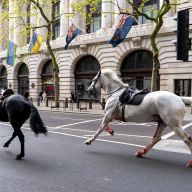Are your shelves laden with too many tchotchkes? It’s time to reduce and rearrange.
If your shelf or table holds dusty salt and pepper shakers from Aunt Carol’s visit to Florida, or dolphin figurines from your parent’s Cuba vacation, or a souvenir beer stein from Uncle Al’s convention trip to Germany, you are probably in design crime territory.
Unless you have a strong emotional connection to any of these knick-knacks, the design team would likely advise you to turf them! We have nothing against you doing it on the sly, so that Uncle Al, Aunt Carol and your parents will not be offended.
The bottom line with knick-knacks is this: less is more. You must purge yourself of decorative items that you do not hold dear. In other words, anything you feel indifferent about, anything you were given but don’t like, or anything you bought simply because a magazine recommended it is not a good enough reason to hang onto it.
The knick-knacks you keep must be intensely personal and they must make you feel good. Either you love them because they have some happy memory for you, or they make you laugh, or simply because you love the way they look.
In the case of knick-knacks it’s all about how they’re arranged. One of the key rules is that similar items should be grouped together. In most cases, we frown upon single knick-knacks sprinkled all over a home because they can end up looking lonely and lost in space. And when we say grouping, we don’t mean items that are clumped and crowded together on a shelf.
Knick-knacks work best in odd-numbered groupings of three, five or seven and can be grouped by theme, colour, shape, or material. For example, you may group coloured glass bottles, or a set of small metal sculptures. Even a collection of tacky travel souvenirs including Aunt Carol’s salt and pepper shakers might work.
To create interest, the size and height of the objects should vary. In addition, try not to arrange the objects in a straight line. You can create depth by overlapping items behind or in front of each other.
Catch Arresting Design every Thursday at 10 p.m. on W Network.
















